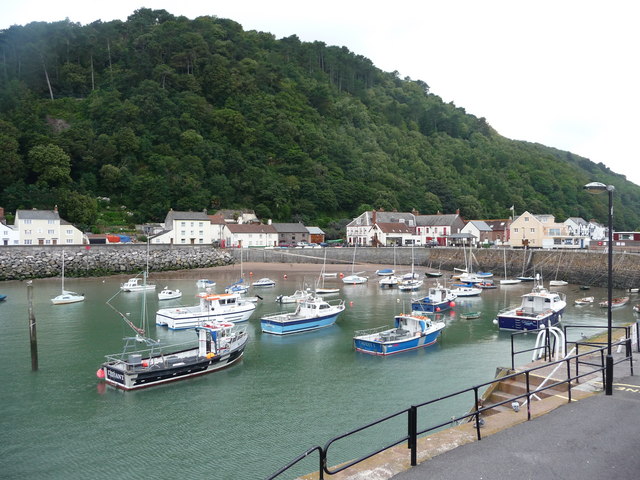There are actually two Porlocks.
There is the village of Porlock a short
distance from the shoreline, and then there is Porlock Weir, a proper little working
harbour nestling at the foot of Exmoor.
Porlock village has some interesting historical features, most notably
in the
parish church, a 13
th century church dedicated to St
Dubricius, which houses the tomb of John Harrington, who fought alongside Henry
V in France.
The
Dovery Manor Museum,
which occupies a medieval manorial dower house dating from 1450, has local
artefacts, displays and pictures as well as a physic garden with
plants grown for medicinal and culinary use.
The village and surrounding area was frequented by the poet Coleridge,
who lived nearby and who went walking in the area with Wordsworth.
Their friend Robert Southey wrote a poem
called “Porlock” in 1798.
The poem
describes the “verdant vale so fair to sight”, “lofty hills which fern and
furze imbrown” and “waters that roll musically down thy woody glens” – a pretty
accurate depiction of Porlock’s picturesque surrounds.
There is a walking trail named after
Coleridge, the
Coleridge Way, which ends in Porlock outside the Visitor Centre.
One of the things Porlock is particularly well known for,
particularly among cyclists, is the legendary Porlock Hill, which forms part of
the A39 heading west towards Lynton.
According to the RCUK cycling website, the hill’s vital statistics are:
length 2.5Km, elevation 304m, average gradient 12% and maximum gradient
25%.
However, for those who find such
gradients too much of a challenge there is an alternative route in the form of
the
Porlock Toll Road, which is longer but only with an average 5% gradient.
The Toll Road, which is used by cars and
walkers as well as cyclists, also offers fabulous views.
Porlock Weir with its 15th century harbour was
once a busy port thanks to its role in handling coal imports from Wales. Now it is frequented by yachts and fishing
boats, and is a popular tourist spot due to its beautiful setting and its
handful of shops, its harbourside inn and fine dining hotel. It was the Saxons who originally developed a
port and fishery here and it was also they who repelled two major attacks by
the Danes in 886 and again in 918. In
1052 a further attack came, this time at the hands of Harold (he of the Battle
of Hastings), who had come across from Ireland.
The many quaint buildings in the vicinity of the harbour include the 17th
century Gibraltar Cottages. The
waterside location of the cottages proved to be their downfall in 1910 when a
tidal wave event flooded them. On Porlock Beach the remains of a submerged forest can be seen at low tide, and in 1999 the bones of an aurochs (wild ox) were discovered on the beach. A 2-mile
walk from Porlock Weir leads to Culbone, where England’s smallest church, St
Beuno’s, can be found. You may as well
leave the car behind for this one, because the church is only accessible on
foot.
 |
Porlock Weir Public House - geograph.org.uk - 520858. Photo by Geoff Lees, via Wikimedia Commons.
|
|



